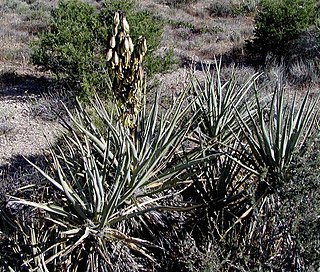
Yucca baccata is a common species of yucca native to the deserts of the southwestern United States and northwestern Mexico, from southeastern California north to Utah, east to western Texas and south to Sonora and Chihuahua. It is also reported in the wild in Colombia.

Eriophyllum lanatum, with the common names common woolly sunflower, Oregon sunshine and golden yarrow, is a common, widespread, North American plant in the family Asteraceae.
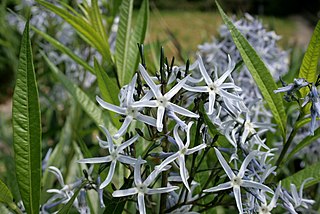
Amsonia is a genus of flowering plants in the dogbane family, Apocynaceae, first described as a genus in 1788. It is native primarily to North America with one species in East Asia and another in the eastern Mediterranean. It was named in honor of the American physician John Amson. Members of the genus are commonly known as bluestars.
- Amsonia ciliataWalter – fringed bluestar – SE US, S Great Plains
- Amsonia elliptica(Thunb. ex Murray) Roem. & Schult. – Japanese bluestar – China, Japan, Korea
- Amsonia fugateiS.P.McLaughlin – San Antonio bluestar – New Mexico
- Amsonia grandifloraAlexander – Arizona bluestar – Arizona, Sonora, Durango
- Amsonia hubrichtiiWoodson – Hubricht's bluestar – Arkansas, Oklahoma
- Amsonia illustrisWoodson – Ozark bluestar – Mississippi Valley, also Nevada
- Amsonia jonesiiWoodson – Jones' bluestar – Arizona, New Mexico, Utah, Colorado
- Amsonia kearneyanaWoodson – Kearney's bluestar – Baboquivari in Pima Co. in Arizona
- Amsonia longifloraTorr. – tubular bluestar – Arizona, New Mexico, Texas, Coahuila
- Amsonia ludovicianaVail – Louisiana bluestar – Louisiana, Mississippi, Georgia
- Amsonia orientalisDecne. – European bluestar – Greece, Turkey
- Amsonia palmeriA.Gray – Palmer's bluestar – Arizona, New Mexico, Texas, Sonora, Chihuahua
- Amsonia peeblesiiWoodson – Peebles' bluestar – Arizona
- Amsonia repensShinners – creeping bluestar – E Texas, SW Louisiana
- Amsonia rigidaShuttlw. ex Small – stiff bluestar – from Georgia to Louisiana
- Amsonia tabernaemontanaWalter – eastern bluestar – S + C + E United States
- Amsonia tharpiiWoodson – feltleaf bluestar – W Texas, SE New Mexico
- Amsonia tomentosaTorr. & Frém. – woolly bluestar – SW US; Chihuahua

Isocoma, commonly called jimmyweed or goldenweed, is a genus of North American semi-woody shrubs in the family Asteraceae. It is found in the semi-arid areas of Southwestern United States and Mexico.

Ericameria nauseosa, commonly known as chamisa, rubber rabbitbrush, and gray rabbitbrush, is a shrub in the sunflower family (Aster) found in the arid regions of western North America.

Cycladenia humilis is the sole member of the monotypic genus Cycladenia. Known by the common name Sacramento waxydogbane, it is an uncommon plant native to the southwestern United States. Collections have mostly been from California, although the species has also been reported from Utah and Arizona, mostly on gypsum soils. It is found at some elevation in several mountain ranges in the region. One of the four varieties of this plant, called the Jones waxydogbane, is considered a threatened taxon. This is a fleshy perennial herb with dull green leaves and pinkish lavender flowers. The flowers begin as rolled tubes shaped like pea pods and then open into colorful funnel-shaped blooms.

Cirsium arizonicum, the Arizona thistle, is a North American species of thistle in the family Asteraceae, native to the southwestern United States and northwestern Mexico. It has been found in Arizona, southeastern California, New Mexico, Nevada, Colorado, Utah, Sonora, and northwestern Chihuahua.

Senecio flaccidus, formerly recorded as Senecio douglasii, member of the daisy family and genus Senecio also known as threadleaf ragwort, is a native of the southwestern Great Plains of North America.

Hymenopappus filifolius is a North American species of flowering plant in the daisy family known by the common names fineleaf hymenopappus and Columbia cutleaf. It is native to western and central North America from Alberta and Saskatchewan south as far as Chihuahua and Baja California.
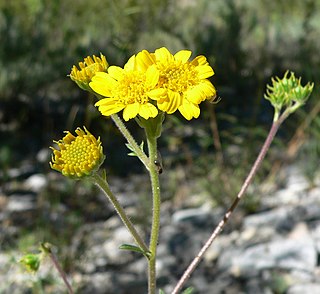
Hymenothrix is a small genus of North American flowering plants in the daisy family known as thimbleheads. They are native to the southwestern United States and northern Mexico.
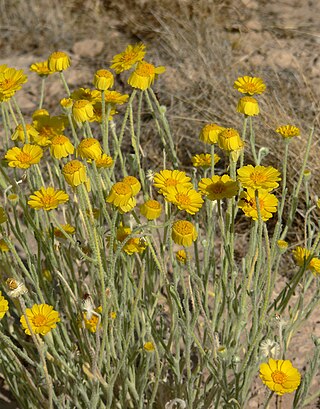
Baileya pleniradiata is a North American species of flowering plant in the daisy family, known by the common name woolly desert marigold. It is native to desert regions of the southwestern United States and northern Mexico, where it grows in sandy habitats. It has been found in the States of Chihuahua, Sonora, Baja California, Arizona, Utah, and Nevada.
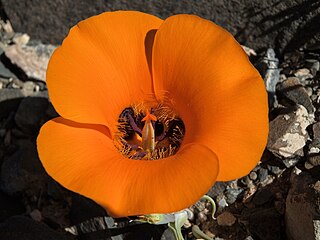
Calochortus kennedyi is a North American species of flowering plant in the lily family known by the common name desert mariposa lily.

Ceanothus pauciflorus, known by the common name Mojave ceanothus, is a species of flowering shrub in the buckthorn family, Rhamnaceae. It is native to the Southwestern United States and Mexico, where it grows primarily in shrubland communities at moderate to high elevations. It is characterized by oppositely arranged leaves, corky stipules and white flowers. It was formerly known as Ceanothus greggii.

Cirsium scariosum is a species of thistle known by the common names meadow thistle, elk thistle and dwarf thistle. It is native to much of western North America from Alberta and British Columbia, south to Baja California. There are also isolated populations on the Canadian Atlantic Coast, on the Mingan Archipelago in Québec, where it is called the Mingan thistle.

Glossopetalon spinescens, syn. Forsellesia spinescens, is a species of flowering shrub in the family Crossosomataceae known by the common names greasebush, spiny greasebush, Nevada greasewood and spring greasebush.

Dieteria canescens is an annual plant or short lived perennial plant in the family Asteraceae, known by the common names hoary tansyaster and hoary-aster.

Phoradendron juniperinum is a species of flowering plant in the sandalwood family known by the common name juniper mistletoe. It is native to the southwestern United States and northern Mexico, where it grows in various types of woodland habitat. It has been reported from California, Nevada, Arizona, New Mexico, Oregon, Utah, Texas, Chihuahua and Sonora.

Tidestromia lanuginosa, commonly known as woolly tidestromia, woolly honeysweet, honeysweet, or honeymat in English and as hierba lanuda, hierba ceniza, or espanta vaqueras in Spanish, is a species of plant in the family Amaranthaceae. It is a low growing annual found in the United States, Mexico, and the Dominican Republic.

Astragalus amphioxys, common name crescent milkvetch, is a plant found in the American southwest, including the whole of Utah, the southeast part of Nevada, the north part of Arizona, the western part of Colorado, the northwestern part of New Mexico, and one county in Texas. It was first described by Asa Gray in 1878.

Dieteria asteroides, the fall tansyaster, is a North American species of plants in the sunflower family. It is native to the southwestern United States and northern Mexico.



















